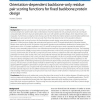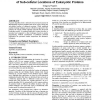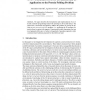159 search results - page 12 / 32 » Comparing approaches to predict transmembrane domains in pro... |
HICSS
2003
IEEE
14 years 1 months ago
2003
IEEE
We have used comparative genome analyses to produce annotated maps for large genomic loci. The first example is a locus on mouse chromosome 9 that is syntenic to human chromosome ...
BMCBI
2010
2010
Orientation-dependent backbone-only residue pair scoring functions for fixed backbone protein design
13 years 8 months ago
Background: Empirical scoring functions have proven useful in protein structure modeling. Most such scoring functions depend on protein side chain conformations. However, backbone...
BMCBI
2007
13 years 8 months ago
2007
Background: Identification of the structural domains of proteins is important for our understanding of the organizational principles and mechanisms of protein folding, and for ins...
GECCO
2008
Springer
13 years 9 months ago
2008
Springer
A genetic algorithm (GA) is utilised to discover known and novel PROSITE-like sequence templates that can be used to classify the sub-cellular location of eukaryotic proteins. Whi...
LPAR
2005
Springer
14 years 1 months ago
2005
Springer
Abstract. The paper describes the formalization and implementation of an efficient constraint programming framework operating on 3D crystal lattices. The framework is motivated an...




